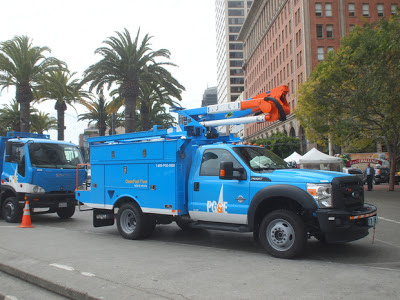We like to honor correct use of words, so that we know what everyone is saying. If we don’t guard against losing the track of the meaning of each word, we run the risk of being unable to communicate. What would “Hybrid Truck” mean to you? A truck with a drive-train where some of the power comes from electric motors, like it does on a Prius? What if there is a completely different meaning for “Hybrid Truck,” with electric motors that have zero connection to the wheels, but still make sense to be called a Hybrid? PG&E, with the help of truck equipment maker Altec, has built some trucks of this sort.
Looks like a typical electrical utility bucket truck, because it is. It’s a Ford F450 that’s equipped to burn Biodiesel (B20), equipment lockers on the back, and a boom/bucket rig up top. That rig is made by Altec, a company that makes the majority of such equipment sold in the U.S.
It’s a little hard to read though, but on the side it’s painted with a logo saying this truck is part of PG&E’s clean fleet, and that it’s a Hybrid.
A Hybrid where the drive train has zero electrification. How does that work?
It depends on how you define Hybrid. With traditional boom/bucket rigs, the truck engine has to be idling to provide power through a PTO gadget to the hydraulic system. The Altec rig on this truck is electrically driven, however, and can be operated in an engine-off situation.
Hence, it is Hybrid in the sense that the systems on-board the truck displace some of the time the engine would be running.
The system is a big win because instead of keeping the engine idling while the worker is working, the work rig is electrically powered. Fuel use and emissions output are drastically reduced. While the rig adds a lot to the cost of the truck, PG&E’s Dave Meisel says the trucks pay for themselves in 3 years thanks to fuel and maintenance savings.
How do the savings work out? Because the truck isn’t idling, fuel use is reduced. The engine also sees fewer hours of operation, meaning less frequent maintenance. Because idling is bad on engines anyway, the engine lifespan is extended. Other benefits include not just emissions reduction, but noise pollution reduction, and reduction of cardiovascular disease among line workers who’d be spending a lot of time next to an idling diesel engine.
The results seen by PG&E are so good that the above truck is now the standard configuration for this sort of truck. The company is halfway to conversion of their entire bucket truck fleet (nearly 600 trucks) to this system.
Altec has designed a whole system (http://www.altec.com/products/green-fleet/![]() ) that includes battery management, battery controls, an electrically operated hydraulic system, and even power export in the bucket so the crew can use electrical power tools rather than gasoline ones.
) that includes battery management, battery controls, an electrically operated hydraulic system, and even power export in the bucket so the crew can use electrical power tools rather than gasoline ones.
Altec also makes similar systems for larger trucks and booms.
This is an AM55 Material Handler, which PG&E sends out for larger jobs than the truck shown earlier. Because it gets used less frequently the payback time for this truck is longer than the bucket truck.
The specs on the bucket truck are:
- 48 volt battery pack, using AGM batteries, with 7 kilowatt-hour capacity
- Fuel use reduction: 30%
- Potential job site usage: 3 hours
- Battery pack can charge from 120 volt charger, or off the vehicle alternator
- Charge time 6-8 hours
- The pack also operates an air conditioning and heating system in the cab
The specs on the material handler are:
- Lithium-Ion-Phosphate battery pack, 18 kilowatt-hours in size
- Job site usage, 60+ minutes of boom operation
- Charges from either 120 volt charger or vehicle alternator
- 120 volt exportable power
- Highway design could decrease death and injury risk, if “we” chose smarter designs - March 28, 2015
- GM really did trademark “range anxiety”, only later to abandon that mark - March 25, 2015
- US Government releases new regulations on hydraulic fracturing, that some call “toothless” - March 20, 2015
- Tesla Motors magic pill to solve range anxiety doesn’t quite instill range confidence - March 19, 2015
- Update on Galena IL oil train – 21 cars involved, which were the supposedly safer CP1232 design - March 7, 2015
- Another oil bomb train – why are they shipping crude oil by train? – Symptoms of fossil fuel addiction - March 6, 2015
- Chevron relinquishes fracking in Romania, as part of broader pull-out from Eastern European fracking operations - February 22, 2015
- Answer anti- electric car articles with truth and pride – truth outshines all distortions - February 19, 2015
- Apple taking big risk on developing a car? Please, Apple, don’t go there! - February 16, 2015
- Toyota, Nissan, Honda working on Japanese fuel cell infrastructure for Japanese government - February 12, 2015

















